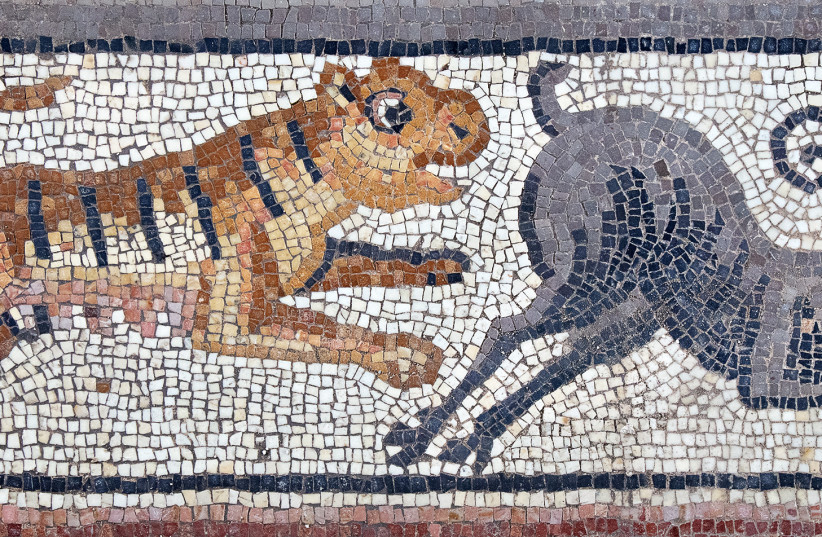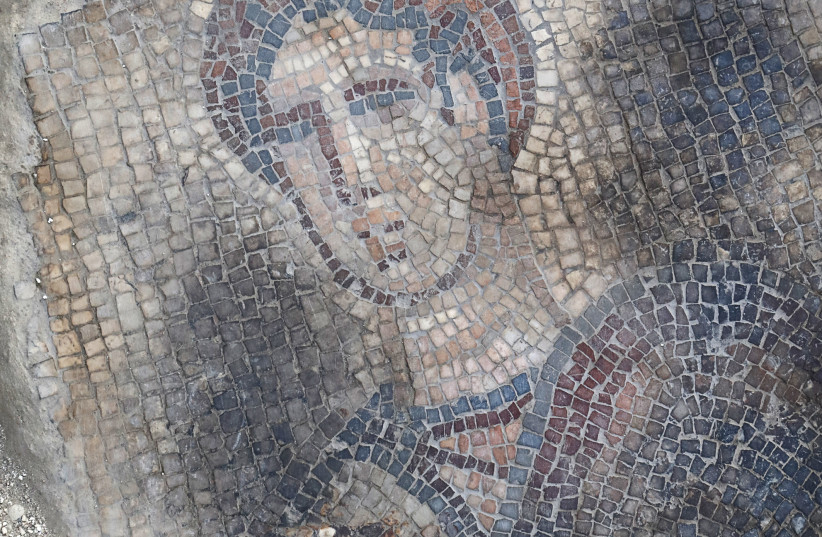Mosaics of biblical Samson uncovered in Galilee archaeological dig
Over the course of the decade-long Huqoq excavation project, the team made a series of discoveries including depictions of Noah’s Ark, the parting of the Red Sea, a Helios-zodiac cycle, and more.
A Roman-era mosaic depicting the biblical prophet Samson has been uncovered by archaeologists at the 1,600-year-old synagogue at Huqoq, an ancient Jewish village in the Lower Galilee.
The discovery was made as part of an international archaeological effort led by Prof. Jodi Magness from the University of North Carolina at Chapel Hill.
The excavation project has shone a light on the Land of Israel in the late Roman era of around 400 CE, revealing much about the socio-cultural dynamics of the period.
Situated near the main entrance of the synagogue, the newly uncovered mosaic consists of a substantial panel displaying a Hebrew inscription framed within a wreath. Complementing this centerpiece is an Aramaic inscription nearby and below appears to record either the names of the generous patrons who financed the synagogue's mosaics, or the artists who brought them to life.
This inscription stands as a timeless testament to their contribution, expressing a desire for their memory to be cherished. The wreath is flanked on both sides by a pair of lions laying their forepaws on bulls’ heads. The mosaic panel is also entirely surrounded by a decorated border that features predatory animals hunting their prey.
Mosaic panels depicting key moments in the life of the biblical figure, Samson, had been uncovered in the excavation seasons of 2012 and 2013. These include vivid portrayals of Samson's exploits with the foxes, as narrated in Judges 15:4, and the heroic episode of Samson hauling the Gaza gate on his shoulders, as detailed in Judges 16:3.
This year's dig added further depth to the Samson narrative, as newly exposed sections included a Philistine horseman and a slain Philistine soldier with a striking, classic face.
Earlier findings, including the earliest known depictions of biblical heroines Deborah and Jael
The year prior, the team discovered another panel, which is separated into three horizontal sections. It brought to life scenes from Judges chapter 4, depicting the prophetess and judge Deborah under a palm tree, gazing at a shield-equipped Barak, and the Kenite woman Yael driving a tent stake through the temple of Canaanite general Sisera, who lies on the ground with blood gushing out of his head. These findings hold the distinction of being the earliest known depictions of biblical heroines Deborah and Jael.

Over the course of the decade-long Huqoq excavation project, the team made a series of discoveries that have shed light on our historical understanding. Among these finds is a Hebrew inscription surrounded by human figures, animals, and mythological creatures, including putti or cupids. Additionally, for the first time ever in an ancient synagogue, a non-biblical story was found depicted in a mosaic panel, which might portray the legendary meeting between Alexander the Great and the Jewish high priest.
One panel captured the moment when two of the spies sent by Moses to explore Canaan were carrying a pole with a cluster of grapes, labeled "a pole between two," as described in Numbers 13:23. Another panel showed a man leading an animal on a rope, accompanied by the inscription "a small child shall lead them" from Isaiah 11:6. A set of animal figures, identified by an Aramaic inscription, represented the four beasts corresponding to the four kingdoms mentioned in the Book of Daniel, chapter 7.
A large panel found in the northwest aisle illustrated Elim, the oasis where the Israelites camped by 12 springs and 70 date palms after leaving Egypt, as referenced in Exodus 15:27.
Other substantial findings included depictions of Noah’s Ark, the parting of the Red Sea, a Helios-zodiac cycle, Jonah being swallowed by three fish, and the building of the Tower of Babel.
Evidence found of the synagogue's reconstruction and a nearby colonnade
Adding to the site's historical significance, the archaeologists found evidence of reconstruction and expansion of the synagogue in the early 14th century CE (the late medieval/Mamluk period). This activity coincided with the creation of an international highway linking Cairo and Damascus that ran alongside Yakuk (Huqoq's medieval name), suggesting an increase in the area's strategic importance. The period also saw the rise of a local tradition of identifying the nearby Tomb of Habakkuk, which subsequently became a focal point of late medieval Jewish pilgrimage.
The dig from 2022 and 2023 further revealed a large stone-paved courtyard, encircled by a row of columns known as a colonnade, east of the synagogue. This courtyard saw reuse in the late medieval period when a massive, vaulted structure of unknown function was erected on top of it.
As this final excavation season wraps up, the archaeologists will hand over the site to the Israel Antiquities Authority and the Keren Kayemet LeIsrael-Jewish National Fund. The new caretakers plan to develop the site into a unique tourist attraction, inviting visitors to marvel at these historical gems firsthand.
Over the years, the excavation has been sponsored by a consortium of educational institutions, including UNC-Chapel Hill, Austin College, Brigham Young University, and the University of Toronto. The project has also benefitted from financial backing by the Kenan Charitable Trust, the College of Arts and Sciences, and the Carolina Center for Jewish Studies at UNC-Chapel Hill.


No comments:
Post a Comment
Stick to the subject, NO religion, or Party politics